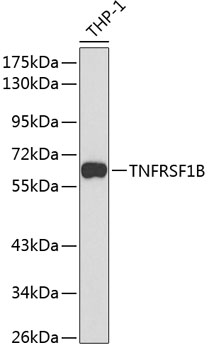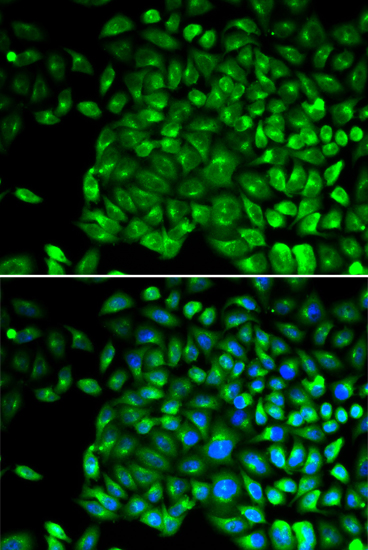Anti-TNFRSF1B Antibody (CAB0387)
- SKU:
- CAB0387
- Product type:
- Antibody
- Reactivity:
- Human
- Host Species:
- Rabbit
- Isotype:
- IgG
- Antibody Type:
- Polyclonal Antibody
- Research Area:
- Cell Death
Frequently bought together:
Description
| Antibody Name: | Anti-TNFRSF1B Antibody |
| Antibody SKU: | CAB0387 |
| Antibody Size: | 20uL, 50uL, 100uL |
| Application: | WB IF |
| Reactivity: | Human |
| Host Species: | Rabbit |
| Immunogen: | Recombinant fusion protein containing a sequence corresponding to amino acids 30-250 of human TNFRSF1B (NP_001057.1). |
| Application: | WB IF |
| Recommended Dilution: | WB 1:500 - 1:2000 IF 1:50 - 1:200 |
| Reactivity: | Human |
| Positive Samples: | THP-1 |
| Immunogen: | Recombinant fusion protein containing a sequence corresponding to amino acids 30-250 of human TNFRSF1B (NP_001057.1). |
| Purification Method: | Affinity purification |
| Storage Buffer: | Store at -20°C. Avoid freeze / thaw cycles. Buffer: PBS with 0.02% sodium azide, 50% glycerol, pH7.3. |
| Isotype: | IgG |
| Sequence: | TPYA PEPG STCR LREY YDQT AQMC CSKC SPGQ HAKV FCTK TSDT VCDS CEDS TYTQ LWNW VPEC LSCG SRCS SDQV ETQA CTRE QNRI CTCR PGWY CALS KQEG CRLC APLR KCRP GFGV ARPG TETS DVVC KPCA PGTF SNTT SSTD ICRP HQIC NVVA IPGN ASMD AVCT STSP TRSM APGA VHLP QPVS TRSQ HTQP TPEP STAP STSF LLPM GPSP P |
| Gene ID: | 7133 |
| Uniprot: | P20333 |
| Cellular Location: | Cell membrane, Secreted, Single-pass type I membrane protein |
| Calculated MW: | 28kDa/48kDa |
| Observed MW: | 65kDa |
| Synonyms: | CD120b, TBPII, TNF-R-II, TNF-R75, TNFBR, TNFR1B, TNFR2, TNFR80, p75, p75TNFR, TNF Receptor II, TNFRSF1B |
| Background: | The protein encoded by this gene is a member of the TNF-receptor superfamily. This protein and TNF-receptor 1 form a heterocomplex that mediates the recruitment of two anti-apoptotic proteins, c-IAP1 and c-IAP2, which possess E3 ubiquitin ligase activity. The function of IAPs in TNF-receptor signalling is unknown, however, c-IAP1 is thought to potentiate TNF-induced apoptosis by the ubiquitination and degradation of TNF-receptor-associated factor 2, which mediates anti-apoptotic signals. Knockout studies in mice also suggest a role of this protein in protecting neurons from apoptosis by stimulating antioxidative pathways. |
| UniProt Protein Function: | TNF-R2: Receptor with high affinity for TNFSF2/TNF-alpha and approximately 5-fold lower affinity for homotrimeric TNFSF1/lymphotoxin-alpha. The TRAF1/TRAF2 complex recruits the apoptotic suppressors BIRC2 and BIRC3 to TNFRSF1B/TNFR2. This receptor mediates most of the metabolic effects of TNF-alpha. Isoform 2 blocks TNF-alpha-induced apoptosis, which suggests that it regulates TNF-alpha function by antagonizing its biological activity. Binds to TRAF2. Interacts with BMX. 2 isoforms of the human protein are produced by alternative splicing. |
| UniProt Protein Details: | Protein type:Membrane protein, integral; Receptor, cytokine Chromosomal Location of Human Ortholog: 1p36.22 Cellular Component: cell soma; perinuclear region of cytoplasm; integral to membrane; plasma membrane; extracellular region; nucleus; lipid raft Molecular Function:protein binding; tumor necrosis factor receptor activity; ubiquitin protein ligase binding Biological Process: tumor necrosis factor-mediated signaling pathway; DNA damage response, signal transduction resulting in induction of apoptosis; negative regulation of inflammatory response; immune response; RNA destabilization; inflammatory response; positive regulation of membrane protein ectodomain proteolysis; aging |
| NCBI Summary: | The protein encoded by this gene is a member of the TNF-receptor superfamily. This protein and TNF-receptor 1 form a heterocomplex that mediates the recruitment of two anti-apoptotic proteins, c-IAP1 and c-IAP2, which possess E3 ubiquitin ligase activity. The function of IAPs in TNF-receptor signalling is unknown, however, c-IAP1 is thought to potentiate TNF-induced apoptosis by the ubiquitination and degradation of TNF-receptor-associated factor 2, which mediates anti-apoptotic signals. Knockout studies in mice also suggest a role of this protein in protecting neurons from apoptosis by stimulating antioxidative pathways. [provided by RefSeq, Jul 2008] |
| UniProt Code: | P20333 |
| NCBI GenInfo Identifier: | 21264534 |
| NCBI Gene ID: | 7133 |
| NCBI Accession: | P20333.3 |
| UniProt Secondary Accession: | P20333,Q16042, Q6YI29, Q9UIH1, B1AJZ3, |
| UniProt Related Accession: | P20333 |
| Molecular Weight: | 28,461 Da |
| NCBI Full Name: | Tumor necrosis factor receptor superfamily member 1B |
| NCBI Synonym Full Names: | tumor necrosis factor receptor superfamily, member 1B |
| NCBI Official Symbol: | TNFRSF1B |
| NCBI Official Synonym Symbols: | p75; TBPII; TNFBR; TNFR2; CD120b; TNFR1B; TNFR80; TNF-R75; p75TNFR; TNF-R-II |
| NCBI Protein Information: | tumor necrosis factor receptor superfamily member 1B; TNF-R2; TNF-RII; p75 TNF receptor; p80 TNF-alpha receptor; soluble TNFR1B variant 1; tumor necrosis factor receptor 2; tumor necrosis factor beta receptor; tumor necrosis factor receptor type II; tumor necrosis factor binding protein 2 |
| UniProt Protein Name: | Tumor necrosis factor receptor superfamily member 1B |
| UniProt Synonym Protein Names: | Tumor necrosis factor receptor 2; TNF-R2; Tumor necrosis factor receptor type II; TNF-RII; TNFR-II; p75; p80 TNF-alpha receptor; CD_antigen: CD120b; INN: EtanerceptCleaved into the following 2 chains:Tumor necrosis factor receptor superfamily member 1b, membrane form; Tumor necrosis factor-binding protein 2Alternative name(s):TBP-2; TBPII |
| UniProt Gene Name: | TNFRSF1B |
| UniProt Entry Name: | TNR1B_HUMAN |






